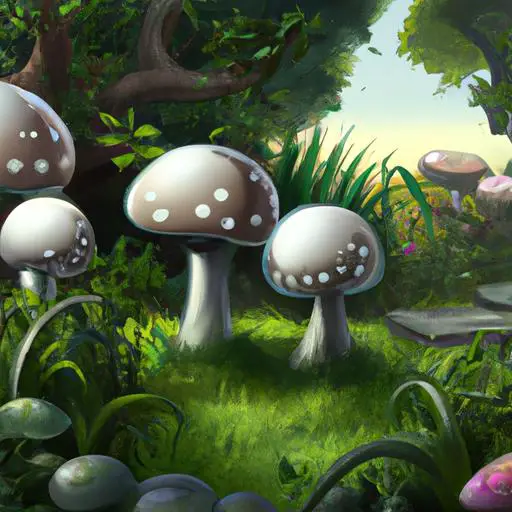Button mushrooms are a common ingredient in many dishes around the world.
But do you ever wonder where they came from and how they grow? In this article, well take a closer look at the origins and varieties of button mushrooms, the nutritional benefits, and how to use them in cooking.
Well also explore the possibility of growing them at home.
So, if youve been looking to learn more about button mushrooms, youve come to the right place!
Table of Contents
Short Answer
Button mushrooms, also known as white mushrooms, are native to Europe and North America.
They were first cultivated in France in the 17th century and have since become popular all over the world.
They typically grow in temperate climates and can be found in fields, woodlands, and gardens.
What Are Button Mushrooms?
Button mushrooms, or Agaricus bisporus, are one of the most commonly consumed mushrooms in the world.
They are also known as white mushrooms, and are widely cultivated and consumed in Europe, North America, and parts of Asia.
Button mushrooms can be found in supermarkets, grocery stores, and farmer’s markets, as well as in restaurants and other culinary establishments.
Button mushrooms are small, round, white mushrooms with a slightly tan cap.
They have a mild, earthy flavor, and a firm texture, making them a versatile ingredient that can be used in a variety of dishes.
They can be eaten raw, cooked, or preserved.
Button mushrooms are rich in vitamins and minerals, including Vitamin B, Vitamin D, calcium, potassium, and magnesium.
They also contain antioxidants, which may have a range of health benefits, including protecting against certain types of cancer and other diseases.
They are a great source of dietary fiber, and are low in calories and fat, making them a popular choice for those looking to maintain a healthy weight.
Where Did Button Mushrooms Originate?

Button mushrooms, also known as white mushrooms, have a long and interesting history that dates back to the 18th century.
It is widely believed that they originated in Europe but they have been cultivated in the United States for over a century.
Button mushrooms are a type of Agaricus bisporus, which is a fungus that grows wild in the forests of Europe, North America, and parts of Asia.
In the wild, button mushrooms can be found growing on tree stumps and logs, but they can also be found in soil and compost.
In the past, button mushrooms were often collected from the wild and consumed by humans, however, today they are mainly cultivated in mushroom farms.
The process of cultivating button mushrooms is relatively simple and involves growing the spores of the mushroom on a substrate, such as compost or soil.
The substrate is then placed in a dark and humid environment and the mushrooms will start to grow.
The process can be sped up by adding extra nutrients, such as nitrogen, to the substrate.
Once the mushrooms have been cultivated, they can be harvested and sold in the market.
Button mushrooms are a popular ingredient in many dishes, including soups, salads, and stir-fries.
They have a mild flavor and a pleasant aroma, and are often used to add flavor and texture to dishes.
So, where did button mushrooms originate? While its difficult to pinpoint their exact origin, its safe to say that they have been grown and enjoyed in many parts of the world for centuries.
Today, button mushrooms are a popular and versatile ingredient that can be found in kitchens around the world.
How Do Button Mushrooms Grow?
Button mushrooms, also known as white mushrooms, are a type of Agaricus bisporus, a fungus that is native to Europe, North America, and parts of Asia.
These mushrooms have been cultivated for over a century in the United States, and they can be grown in many different ways.
When growing button mushrooms, the most common method is to cultivate them in compost, soil, or on logs.
When growing them in compost, the compost must be kept at just the right temperature and humidity.
The compost should also be aerated and kept moist.
The compost should also contain the right amount of nitrogen and other nutrients to promote the growth of the mushrooms.
When growing button mushrooms in soil, the soil must be light and well-draining so that the mushrooms can get the moisture and air they need to grow.
The soil should be enriched with organic matter and fertilizers to ensure the mushrooms have the proper nutrients they need to thrive.
Finally, button mushrooms can also be grown on logs.
This is a more traditional method of growing mushrooms, and it is also the most sustainable.
Logs are a natural habitat for mushrooms, and they can provide the mushrooms with the nutrients they need to grow.
Logs should be kept moist and well-drained, and the logs should also be inoculated with mushroom spawn to ensure the mushrooms can take root and grow.
No matter which method you use to grow button mushrooms, it is important to make sure you are providing the mushrooms with the right environment and nutrients to ensure their success.
If done properly, button mushrooms can be a delicious addition to any meal!
Different Varieties of Button Mushrooms

Button mushrooms, also known as white mushrooms, are one of the most popular and widely consumed mushrooms in the world.
They are a variety of Agaricus bisporus, a species of mushroom that grows in the wild in the forests of Europe, North America, and parts of Asia.
As with other cultivated mushrooms, button mushrooms come in a variety of different varieties, each with their own unique characteristics, textures, and flavors.
The most common variety of button mushroom is the ‘common white’ which has a smooth, white cap and a firm texture.
This variety has a mild flavor and is often used in salads and sandwiches.
Other varieties include the ‘cremini’ which has a slightly darker brown cap and a more robust flavor, ‘portobello’ which has a large, dark-brown cap and a more intense flavor, and ‘shiitake’ which has a dark brown cap and a more earthy flavor.
In addition to these common varieties, there are also some less common varieties of button mushrooms.
‘Oyster’ mushrooms have a light-colored cap and a delicate flavor, while ‘enoki’ mushrooms have a thin, long stem and a mild flavor.
‘Maitake’ mushrooms have a ruffled cap and a slightly woodsy flavor, and ‘chanterelle’ mushrooms have an orange-brown cap and a sweet, nutty flavor.
No matter which variety of button mushroom you choose, they all have one thing in common: they are a delicious and nutritious addition to any meal. Button mushrooms are low in calories and fat and are a great source of protein, fiber, vitamins, and minerals, making them an ideal choice for a healthy diet. So the next time you’re looking for a tasty and nutritious addition to your meal, consider one of the many varieties of button mushrooms.
Nutritional Benefits of Button Mushrooms
Button mushrooms are a type of Agaricus bisporus, a fungus that is widely cultivated for its health benefits and unique flavor.
Not only are button mushrooms a delicious addition to any meal, but they are also an excellent source of nutrition.
This type of mushroom contains a variety of vitamins and minerals, including vitamin B, vitamin D, potassium, magnesium, phosphorus, and zinc.
Additionally, button mushrooms are naturally low in calories and fat, making them a great addition to any diet.
Button mushrooms are also high in antioxidants, which can help protect the body from the damaging effects of free radicals.
They are also high in dietary fiber, which can help aid digestion and promote a healthy gut.
Furthermore, button mushrooms are a good source of protein, providing 8 grams of protein per serving.
This makes them an excellent addition to vegetarian and vegan diets.
Button mushrooms are also known for their anti-inflammatory and immunity-boosting properties.
Studies have shown that button mushrooms contain an array of compounds that can help reduce inflammation and boost the immune system.
Additionally, they are rich in polyphenols, which have been linked to improved blood flow and lower cholesterol levels.
Overall, button mushrooms are an incredibly nutritious and delicious addition to any meal.
They are low in calories and fat, and high in vitamins, minerals, antioxidants, dietary fiber, and protein.
Moreover, they are known for their anti-inflammatory and immunity-boosting properties, making them an excellent choice for anyone looking to improve their health.
Different Ways to Cook with Button Mushrooms

Button mushrooms are incredibly versatile, making them a great addition to any meal.
They can be cooked in a variety of ways, from sauting to roasting to grilling.
Depending on your desired flavor profile, you can choose to cook them with a variety of different spices and herbs to add a unique flavor.
For a savory and umami flavor, you can cook them with garlic and onions.
For a more earthy flavor, try adding thyme or rosemary.
When cooked in a pan with some oil or butter, the mushrooms can develop a rich, meaty flavor that is perfect for adding to salads, pastas, sandwiches, and pizzas.
For a more robust flavor, try roasting or grilling your mushrooms.
Roasting in the oven will give them a nice, smoky flavor, while grilling will give them a nice char.
Another way to cook mushrooms is to add them to soups or stews.
They will add a nice, earthy flavor to the dish, and they will also add a nice texture.
No matter how you choose to cook your mushrooms, they are sure to add a delicious flavor to any meal.
Growing Button Mushrooms at Home
Growing button mushrooms at home is becoming increasingly popular among home gardeners and mushroom enthusiasts alike.
With the right environment, some patience, and a little bit of know-how, anyone can grow their own crop of button mushrooms in their own backyard.
The first step to growing button mushrooms is creating the right environment.
Button mushrooms require a cool, dark, and moist environment in order to thrive.
Keeping the temperature between 50-60 degrees Fahrenheit is ideal and providing a shady spot is important.
The next step is finding the right growing medium.
Button mushrooms can be grown in compost, soil, or on logs.
Compost is the most common medium, as it provides the perfect balance of moisture and nutrition.
It is important to use compost that is specifically designed for growing mushrooms, as regular garden compost may not contain the necessary nutrients.
Once the environment and the growing medium have been established, the next step is to inoculate the growing medium with the mushroom spores.
This is done by adding the mushroom spores to a container of water and stirring to ensure the spores are evenly dispersed.
Once the spores have been dispersed in the water, they can be sprinkled onto the growing medium.
Once the spores have been added, it is important to keep the growing medium moist.
A spray bottle with water can be used to lightly mist the medium every few days.
The mushrooms should start to grow in a few weeks and can be harvested when the caps are still white and closed.
Growing button mushrooms at home is a rewarding experience and can provide a steady supply of mushrooms for the kitchen.
With the right environment and a little bit of patience, anyone can successfully grow their own button mushrooms.
Final Thoughts
Button mushrooms, also known as Agaricus bisporus, have a long and interesting history.
They originated in Europe in the 18th century, but have since been widely cultivated in the United States and parts of Asia.
Not only are button mushrooms a delicious and versatile ingredient for cooking, but they are also offer many nutritional benefits.
With a variety of different types and ways to grow them, button mushrooms are a great addition to any garden or kitchen.
Why not try growing some button mushrooms at home and discover the delicious possibilities for yourself?

